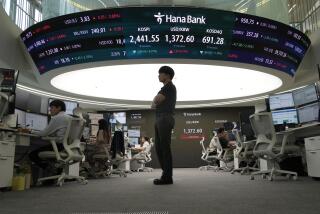Driver Arrogance, Pedestrian Ignorance Blamed : Motoring in S. Korea Seen as Terrifying
- Share via
SEOUL — What’s the most frightening thing about living in South Korea? Students throwing firebombs? Riot police firing tear gas? The threat of invasion from the North?
No, there’s something worse: Driving to work.
This is a country where almost 20% of motorists admit habitual drinking and driving, where the driving test is conducted entirely in first gear and where the road accident death rate is soaring.
Residents of South Korea say driver arrogance and pedestrian ignorance of even the simplest road rules combine to create some of the most dangerous roads in the world.
People Frightened
A recent Gallup Poll in South Korea showed that 75.3% of 1,201 people selected randomly across the country were concerned about traffic safety, and 46.1% felt at risk when driving.
Police figures show why. An average of 32 people were killed and 762 injured every day in 225,062 accidents in 1988, a 60.4% increase over 1987’s death rate.
The Gallup survey also found that 18.2% of South Korean drivers admitted habitually drinking and driving. Almost half of those questioned said they had driven drunk at least once in the last year.
The rules of pedestrian safety are still a foreign language in South Korea, which may explain why people lurch out suddenly in front of speeding cars or often wander along the center dividing line at night as vehicles speed past in both directions.
But it doesn’t explain the driver’s seeming death wish. Turn signals are generally ignored, rear-view mirrors forgotten.
Professionals the Worst
The professionals--taxi and bus drivers and executive chauffeurs--are the worst hazards.
Taxis are motivated to weave dangerously through gridlock traffic and stop suddenly to pick up new fares, buses to keep to unrealistic time schedules and chauffeurs to please their busy bosses.
“What can I do? Everybody’s doing it,” said one taxi driver. “If I don’t drive like everyone else, then I won’t get anywhere. I have even had customers complain when I don’t.”
Matters are further complicated by the dizzy rise in the number of cars on Seoul streets. The Transport Ministry says 403 new cars came onto the streets every day in 1988, and in the first three months of 1989 the daily figure increased to 501.
“It’s getting harder and harder for us to drive,” said one taxi driver. “We don’t even want to go downtown anymore.”
Many of the drivers of those new cars are also new to the road. Every day, at Seoul’s handful of test sites, teeming masses of driving hopefuls shuffle from window to window to get their applications stapled, stamped and initialed.
The driving test has its detractors and its supporters, but most agree on one thing--the exam has little to do with operating a vehicle.
About half the written section is taken up by questions about South Korea’s laws, including such unlikely queries as:
If you use your car to commit a crime, which one of the following is NOT a reason for your license to be revoked: a. larceny, b. robbery, rape and arson, c. kidnaping, d. murder or disposal of a murder victim. The correct answer is “a.”
Encouraged to View Display
Once you’ve cleared that hurdle, you are encouraged to view a display outside.
It’s not a pretty sight. One picture shows a motorcycle so badly mangled it would be unrecognizable if the Honda tag had not survived the crash. An official explains that the motorcycle collided with a truck, killing six people and injuring seven.
Another shows the crushed, blood-spattered front of a bus, with a body still in the driver’s seat and a piece of cloth covering the space where his head should be.
More to Read
Sign up for Essential California
The most important California stories and recommendations in your inbox every morning.
You may occasionally receive promotional content from the Los Angeles Times.










